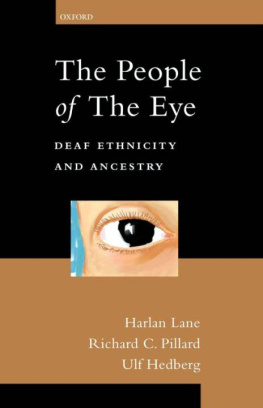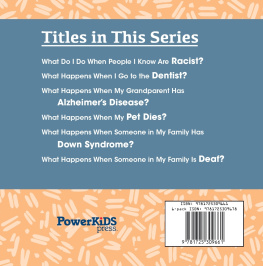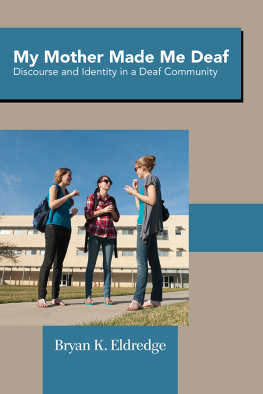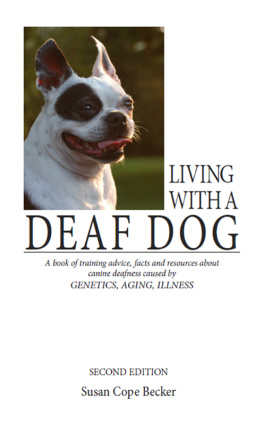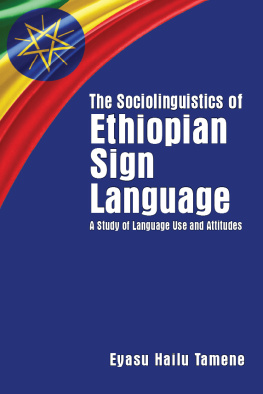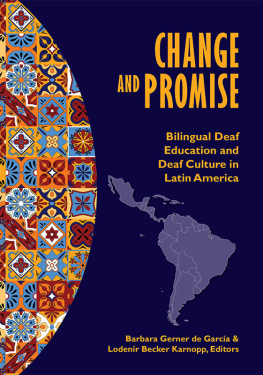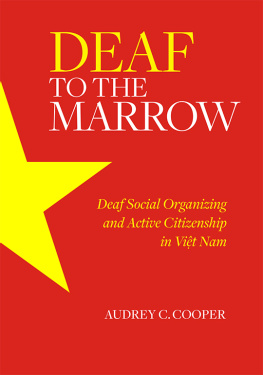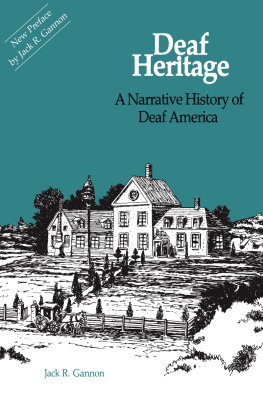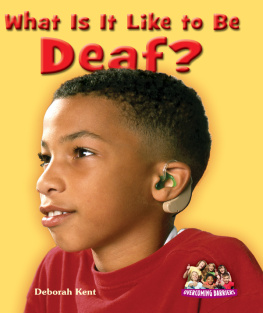"A valuable contribution to Deaf Studies and other fields, The People of the Eye will certainly improve our understanding of humanity."
-Yerker Andersson, President Emeritus, World Federation of the Deaf
"A wonderful contribution that certainly makes a convincing case for Deaf ethnicity."
-Dennis Cokely, Director, American Sign Language Program; Director, World Languages Center, and Professor and Chair, Department of Languages, Literatures and Cultures, Northeastern University
"Outright fascinating."
-Richard Eckert, Assistant Professor, Department of Sociology, University of Wisconsin-Richland
"Elegant prose, meticulous research, and well-aimed quotes make a convincing case for ethnicity. I especially enjoyed the spirited debate in the 'Yes, But' section, which had me on the edge of my seat. The historical portrait of early Deaf American life, which the authors painted so vividly, is sure to inform and inspire many generations to come."
-Anna Mindess, Interpreter Educator, and author of Reading Between the Signs: Intercultural Communication for Sign Language Interpreters
"The genealogical work in this book is groundbreaking. It goes beyond elite-driven histories and shows a dense web of interconnections among grassroots Deaf people. This book fundamentally alters our understanding of the origins of the American Deaf community."
-Joseph Murray, Assistant Professor, Department of Deaf Studies, Gallaudet University
Series Editors
Marc Marschark
Patricia Elizabeth Spencer
A Lens on Deaf Identities
Irene W. Leigh
The World of Deaf Infants: A Longitudinal Study
Kathryn P. Meadow-Orlans, Patricia Elizabeth Spencer, and Lynn Sanford Koester
Sign Language Interpreting and Interpreter Education: Directions for Research and Practice
Edited by Marc Marschark, Rico Peterson, and Elizabeth A. Winston
Advances in the Sign Language Development of Deaf Children
Edited by Brenda Schick, Marc Marschark, and Patricia Elizabeth Spencer
Advances in the Spoken Language Development of Deaf and Hard-of-Hearing Children
Edited by Patricia Elizabeth Spencer and Marc Marschark
The Gestural Origin of Language
David F. Armstrong and Sherman E. Wilcox
Deaf Cognition: Foundations and Outcomes
Edited by Marc Marschark and Peter C. Hauser
The People of the Eye: Deaf Ethnicity and Ancestry
Harlan Lane, Richard C. Pillard, and Ulf Hedberg
Harlan Lane
Richard C. Pillard
Ulf Hedberg
On the nature of the Deaf:
"The deaf are ... first, last, and all the time the people of the eye."
-George Veditz (President, National Association of the Deaf, 1861-1937). Ninth Convention of the National Association of the Deaf and Third World's Congress of the Deaf, 1910. Philadelphia: Philocophus Press, 1912. p. 30.
On sign language and the Deaf:
"The topic that concerns you, gentlemen, rather than an ordinary medical issue is, above all, a lofty question of humanity and civilization which requires deep reflection, not only by doctors but by teachers, philosophers and scholars."
-Ferdinand Berthier (French Deaf leader and educator, 18031886). Observations sur la mimique consideree dons ses rapports avec 1'enseignement des sourds-muets. A M. le President et a Messieurs les Membres de I'Academie Imperiale de Medecine. Paris: Martinet, 1853. (transl. H. Lane)
List of Illustrations xiii
Acknowledgments xv
Introduction xvii
Part I: Ethnicity and the Deaf-World
1. Cultural Cohesive Forces
Language
Bonding to One's Kind
Cultural Rules and Values
Social Institutions
The Language Arts
The Visual Arts
History
Ethnic Territory
Kinship
Ancestry in the Deaf-World
Socialization
2. Ethnic Boundaries
Outside Forces
Inside Forces
Multiethnicity
Summary
3. Yes, But
On Assimilation
On Deaf Bodies
On Socialization
On Other Challenges to Deaf Ethnicity
On Scholarly Recognition
On Disability
On Deaf Diversity and American Pluralism
Notes to Part I
Part II: Deaf Ancestry: Henniker, NH, and Martha's Vineyard, MA
4. Context: Settling the New World
5. The Brown Family of Henniker, NH
6. Martha's Vineyard
Vineyard Lineages
A Kentish Enclave
Life and Marriage on Martha's Vineyard
7. Assimilating and Differentiating Societies
The Bali Example: Desa Kolok
Notes to Part II
Part III: Deaf Ancestry in Maine-Northern Cluster
8. Migration from Martha's Vineyard to Maine
The Smith-Parkhurst Clan
The Davis Clan
The Newcomb Clan
The Smith-Hinckley Clan
The Sebec Lovejoys
The Samuel Allen Clan
9. Other Settlers in the Northern Cluster
The Jellison Clan
The Jack Clan
The Berry Clan
The Lovejoy Clan
Where Deaf People Lived
Notes to Part III
Part IV: Deaf Ancestry in Maine-Southern Cluster
10. Southern Cluster
The Rogers-Holmes Clan
The Badger-Boardwin-Brown-Glidden Clan
The Campbell Clan
The Curtis-Rowe Clan
Notes to Part IV
Part V: Deaf Ancestry: Summary and Reflections
Summary
Reflections
Notes to Part V
Appendices
Appendix A. Briefly Noted Lineages
Appendix B. What the Pedigrees Reveal about Genetic Transmission
Appendix C. Pedigree Methods
Appendix D. Every Name Index to Pedigrees at Our Website
Notes to the Appendices
Figures 2 through 17
Index
We thank the following people who assisted us in gathering, analyzing or displaying our findings: Ms. Ellen Adams, Ms. Carole Browne, Ms. Isabelle Chopin, Ms. Merce Crosas, Ms. Flossie Dere, Col. Wayne Frank, Mr. Jason Freitas, Ms. Mary French, Ms. Emily Gilchrist, Dr. Sue Hotto, Ms. Katarzyna Kaczynski, Ms. Eunice Ladd, Ms. Kay Lam, Ms. Shannon Locke, Mr. Jean-Louis Martinez, Ms. Jillian Motyl, Mr. Edward Murkland, Ms. Kelly Milligan, Mr. Michael Olson, Ms. Harriette Otteson, Ms. Cheryl Patten, Ms. Nancy Porter, Dr. Judy Shepard-Kegl, Mr. Tommy Strunk, Mr. Gary Wait, Ms. Sherry Walrath, Mr. Christian Wayser, Dr. Bencie Woll, Dr. James Woodward, Dr. Del Wynne.
We are indebted to the following colleagues who made many valuable suggestions concerning the manuscript: Dr. Yerker Andersson, Dr. Kathleen Arnos, Dr. Doug Baynton, Dr. Dennis Cokely, Mr. Russell Dover, Dr. Carol Erting, Dr. Francois Grosjean, Dr. Tom Humphries, Dr. Robert E. Johnson, Dr. Paddy Ladd, Dr. Harry Lang, Ms. Ella Lentz, Dr. Ceil Lucas, Dr. Harry Markowicz, Ms. Anna Mindess, Dr. James Morris, Dr. Joseph Murray, Dr. Carol Padden, Mr. Frank Philip, Ms. Joan Poole-Nash, Dr. Rachel Rosenstock, Mr. Gerald Shea, Dr. Theresa Smith, Dr. Ted Supalla.
In addition to the preceding colleagues, we had fruitful discussions of Deaf ethnicity with: Dr. MJ Bienvenu, Mr. Aaron Brace, Dr. Jere Daniell, Dr. Richard Eckert, Dr. Nora Groce, Dr. John Hinnant, Mr. Bill Moody, Ms. Sharon Neumann-Solow, Dr. Vincent Parillo, Mr. Brian Riley, and Dr. James Woodward.
We acknowledge gratefully the following organizations: the Gallaudet University Archives, the Harvard-MIT Data Center of the Institute for Quantitative Social Science, the History Factory, the Maine Historical Society, the Maine State Archives, the Maine State Library, the New England Historic Genealogical Society, Northeastern University Inter-Library Loan service, the Volta Bureau. The Office of the Provost, Northeastern University, provided partial support for this research and for Dr. Lane's sabbatical year. He acknowledges with appreciation the support of his scholarly work by his chair and dean.
The United States has many ethnic groups-it is a hallmark of our culture. This book asks if we have failed to recognize one: Americans whose primary language is American Sign Language (ASL).' No one knows how many such people there are but estimates generally range from half a million to 1 million members in the United States.' For the present purpose, we need to distinguish Deaf ASL signers from the much larger and more heterogeneous group of more than 10 million hearing-impaired Americans who communicate primarily in English or another oral language.2 Most of the people in this larger group had conventional schooling and became deaf after acculturation to hearing society-many of them late in life. Accordingly, they do not see themselves as members of a sign-language minority nor do they participate in its organizations, profess its values, or follow its customs; rather, they consider themselves hearing people with a hearing disability. Something similar is true in all nations: there is a group of visual people3 who use a natural visual-manual language (ASL in the United States) and who are often not distinguished from the larger group of people who view themselves as hearing impaired and who use a spoken language in its oral or written form.4 We warmly endorse calls for greater recognition and study of both groups.5 This book is about the Deaf signers of ASL, for if any class of deaf people constitutes an ethnic group, surely it is the signed language minority. In choosing to address this minority, we also benefit from considerable research about its language, culture, history, and social structure.
Next page
